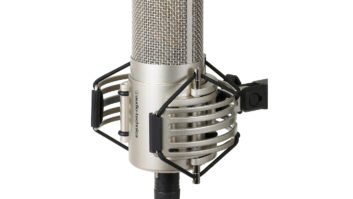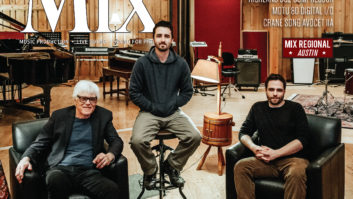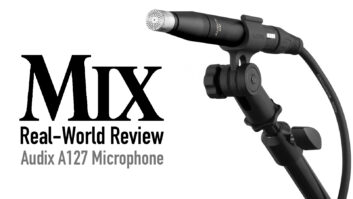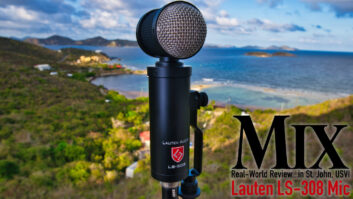I remember reading Pro Sound News’ October, 2013 review of the A-T 5040 with great interest, as it was loaded with superlatives for that unusual mic—four two-micron thin, rectangular diaphragms summed together to create a very large surface area that accurately translated sound without the usual large diaphragm issues (sluggishness, poor transients, harsh off-axis response) or small-diaphragm issues (lower output, higher noise floor). With that review in mind, I was delighted to try this new 5047 and try to determine how it might differ from typical LDCs.
A-T calls the cardioid-only 5040 its ideal vocal mic and appears to indicate the 5047 is the company’s ideal vocal and instrument mic, even though both share the exact same capsules, body and shock mount (the A-T 8480). Yet, the 5047 has higher impedance (150 compared to 50 ohms), about the same extremely low noise floor (six and five dB), higher sensitivity and it can handle another six dB of SPL (a high 148 dB). The crucial difference appears to be the output transformer, which keeps the 5047’s load stable to signal amplification at the preamp, allowing more headroom and dynamic range.
$3,499 purchases the mic, a storage case and the 8480 shock mount, which is worthy of mention. I am prone to anger over nice mics in inadequate mounts, but this mount grabs the mic snugly in a cradle of rubber-ring-cushioned arms that lock into place with a small lever. The result is a requisite firm hold that does not slip at all, even if the suspended assembly sags just a little (which is a little unsightly for a mic of this fine pedigree).
For testing, I had to start with vocals (I mean, really, who wouldn’t?), as I had a familiar and talented voice in for sessions—one who has overloaded a lesser mic with power and has range (both frequency and volume) that puts my gear to the test. Paired with my ultimate vocal channel-strip reference (a top-shelf Millennia-Media STT-1), I dialed in only moderate gain, bypassed EQ, contained levels with some el-op compression and enjoyed the fruits of such labor. The sound quality was excellent, the frequency response seemingly ruler flat and the dynamics were the most unrestrained and natural I think I may have ever heard! Despite these superlatives, it’s not like I was sitting there in disbelief; the sonic reproduction was so effortless and true that I took it for granted nearly immediately, no euphony or epiphanies here.
Next up, I had a fantastic rock drummer who would surely provide quality tones for serious evaluation. I only had one 5047 or else overheads would have been the natural choice. My usual coterie of mics was getting me a kit sound that was already ideal, so I added the 5047 as a center overhead to grab more snare (the cardioid pattern has great side rejection, typical of rectangular diaphragms). Paired up with my AMS-Neve 4081 mic amp (and no EQ or compression), I heard a sound on playback I was not accustomed to from any single mic—it was basically the sound I heard in the room. Such a rare signature, it was a combination of seemingly flat mids, coupled with bass extension that was colorless and punchy, as well as a top-end that was truer than any (comparatively) sizzly LDC, less pingy than any SDC and more truthful in frequency and dynamics than any ribbon (active or passive).
I realized now my challenge was to find weakness in this mic. Sorry A-T; it’s all in a day’s work. I knew what to do—I’m as picky as all-get-out about LDCs on electric guitar amps, so I put the 5047 right smack at the grill in front of my Vox AC30 with Celestion-cab, where many a LDC will either overload, need a pad or just sound irritating. You’ve guessed it: The 5047 handled the SPL without restraint, translated all the frequencies without harshness and required no EQ other than high-passing in my mix.
Exhibiting at the 2018 NAB Show? Enter the NewBay Best of Show Awards! EXTENDED DEADLINE: MARCH 30!!!
In all my subsequent test recordings and tracks, I didn’t learn much of anything new; the 5047 “hears” a lot like your ears and doesn’t contribute much. Acoustic guitar sounded like acoustic guitar (neither woofy, nor crispy, nor boxy), piano sounded like piano (the polar pattern did reject a lot of room), vocalists (men, women, singers, talkers, et al.) sounded like the person sounded (a little dark if they’re mumbly, a little strident if they’re thin). Now, if you do want to get colored up with some extra brightness—and I sometimes did with electric guitars and vox—I found a little 5k presence peak did the trick and the 5047 accepted top EQ rather nicely for an LDC, sort of like ribbons do.
Hearing this mic in action has been revelatory if a bit depressing. I would really like to make a pair of these mics my “go to’s” for piano, drum overheads, acoustic guitar and such, but that’s not possible for me at this price point. This 5047 is only $500 more than the 5040 and I’m pretty sure that it is worth it for the extra headroom, sensitivity and transformer-stability. If you can afford one—or better yet, two—of these 5047s, allow me to recommend them whole-heartedly. This much accuracy, musicality and reference-quality would be ideal for almost any musical, vocal, Foley, classical or sound FX sound capture, transduction and reproduction.
Audio-Technica • www.audio-technica.com







